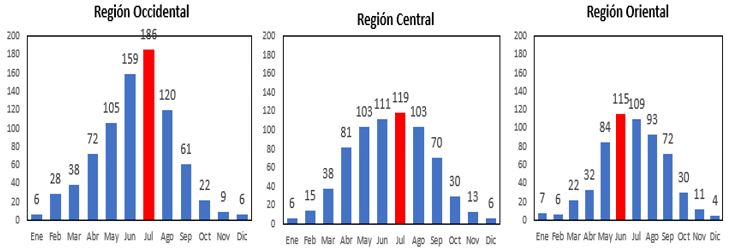Behavior of the days with sls reports in the Cuban regions and its relationship with the phases of enso events in the period 1990-2020
Main Article Content
Abstract
Severe Local Storms affect the Cuban territory at any time of the year and constitute one of the main variations in climate. These variations seem to be associated with very low-frequency oscillations or cycles in background climatic conditions, within processes of natural climate variability. One of these oscillations is El Niño – Southern Oscillation, which plays an important role as a forcing element in Cuba's climatic variability. Taking into account the above, in this research the objetives are: find the monthly distribution of the Severe Local Stroms in the regions of Cuba, finding the months of greatest severity, as well as its relationship with the phases of the El Niño - Southern Oscillation event and analyze the relationship between the days with reports of Severe Local Storms and the intensity of El Niño - Southern Oscillation phases in the rainy and dry season. Among the materials and methods used are El Niño – Southern Oscillation Index database and the Severe Local Storms reports database. It was shown that the months with the highest occurrence of severe activity coincide with the rainy period of the year and the least active with the dry season, resulting in the months from May to August as those with the highest frequency of Severe Local Storms, highlighting July as the month of maximum severe activity for the west and center and June for the eastern zone. In addition, it was observed that the phase that most favored the occurrence of Severe Local Storms was the Neutral phase of the El Niño – Southern Oscillation event, followed by the warm phase and, to a lesser extent, the cold phase.
Downloads
Article Details

This work is licensed under a Creative Commons Attribution-NonCommercial 4.0 International License.
Those authors who have publications with this journal accept the following terms of the License Attribution-NonCommercial 4.0 International (CC BY-NC 4.0):
You are free to:
- Share — copy and redistribute the material in any medium or format
- Adapt — remix, transform, and build upon the material
The licensor cannot revoke these freedoms as long as you follow the license terms.
Under the following terms:
- Attribution — You must give appropriate credit, provide a link to the license, and indicate if changes were made. You may do so in any reasonable manner, but not in any way that suggests the licensor endorses you or your use.
- NonCommercial — You may not use the material for commercial purposes.
- No additional restrictions — You may not apply legal terms or technological measures that legally restrict others from doing anything the license permits.
The journal is not responsible for the opinions and concepts expressed in the works, they are the sole responsibility of the authors. The Editor, with the assistance of the Editorial Committee, reserves the right to suggest or request advisable or necessary modifications. They are accepted to publish original scientific papers, research results of interest that have not been published or sent to another journal for the same purpose.
The mention of trademarks of equipment, instruments or specific materials is for identification purposes, and there is no promotional commitment in relation to them, neither by the authors nor by the publisher.
References
Alfonso, A. P. (1994). Climatología de las tormentas locales severas de Cuba. Cronología. Editorial Academia, La Habana. 168 p. https://isbn.cloud/9789590200601/climatologia-de-las-tormentas-locales-severas-cronologia
Álvarez, L. (2006). Estudio de la localización espacial de las tormentas eléctricas en Cuba y su tendencia. Tesis presentada en opción del grado de Doctor en Ciencias Meteorológicas, Instituto de Meteorología, 149 p. Available: UDICT Instituto de Meteorología file:///C:/scielo/serial/cu-rcm/v27n1/xsl/html/www.insmet.cu
Carnesoltas, M. (2002). La brisa de mar y tierra. Conceptos fundamentales. Revista Cubana de Meteorología, 9(1):39–60. http://rcm.insmet.cu/index.php/rcm/article/view/340
Carnesoltas M., Aguilar G., Naranjo L. (2010). Condiciones a escala sinóptica favorables para la aparición de tormentas locales severas en Cuba. Período lluvioso. Revista cubana de meteorología / vol.16 no.1. http://rcm.insmet.cu/index.php/rcm/article/view/128
Centella, A.; Naranjo, L.; Paz, L.; Cárdenas, P.; Lapinel, B.; Ballester, M.; Pérez, R.; Alfonso, A.; González, C. & Limia, M. (1997). Variaciones ycambios del clima en Cuba. Reporte de Investigación., La Habana, Cuba: Centro Nacional del Clima, Instituto de Meteorología, 59 p. https://repositorio.geotech.cu/jspui/bitstream/1234/2820/3/Impacto%20del%20Cambio%20Clim%C3%A1tico%20y%20Medidas%20de%20Adaptaci%C3%B3n%20en%20Cuba%20CAPITULO%2002.pdf
Centella, A.; Llanes, J. & Paz, L. (2001). República de Cuba: Primera Comunicación Nacional a la Convención Marco de las Naciones Unidas sobre Cambio Climático. La Habana: Instituto de Meteorología de Cuba, 169 p. https://unfccc.int/sites/default/files/resource/Cuba%20INC.pdf
Magaña V., Pérez J. L., Vázquez J. L., Carriosoza E. y Pérez J. (1999). El Niño y El Clima. Los impactos de El Niño en México. En Magaña R.V.O. (Ed). Sep - CONACYT. 229. pp. https://iri.columbia.edu/~idb_enso/luisbrito/Impacts.html
Maturana J., Bello M., Manley M. (2004). Antecedentes históricos y descripción del fenómeno El Niño, Oscilación del Sur. Servicio Hidrográfico y Oceanográfico de la Armada de Chile. Departamento de Oceanografía. Errázuriz 254, Playa Ancha, Valparaíso. http://www.cona.cl/pub/libro_elnino/1maturana.pdf
Naranjo, L. (1994). Uso de los Índices de Circulación para la caracterización de las condiciones atmosféricas en las inmediaciones de Cuba. Reporte de Investigación. Grupo Nacional de Pronóstico a Largo Plazo, La Habana, Cuba: Instituto de Meteorología, 52 p.
OMM. (2014). El Niño/Oscilación del Sur, Tiempo – clima – agua, No.1145. https://docplayer.es/12960509-Omm-no-1145-el-nino-oscilacion-del-sur.html
Pabón J., Montealegre J. (2017). Los fenómenos de El Niño y de La Niña, su efecto climático e impactos socioeconómicos, Academia colombiana de ciencias exactas, físicas y naturales, Colección Jorge Álvarez Lleras no. 34, Bogotá D.C, Colombia. https://repositorio.accefyn.org.co/bitstream/001/113/1/Fenomeno%20del%20ni%C3%B1o%20y%20la%20ni%C3%B1a%20WEB.pdf
Pérez R., Salas I., Dole J. (2004). El evento ENOS y la QBO y su influencia sobre Cuba y los mares adyacentes, Instituto de Meteorología, CITMA, Ciudad de La Habana, Cuba. https://repositorio.geotech.cu/jspui/bitstream/1234/1624/1/El%20Evento%20ENOS%2C%20la%20QBO%20y%20su%20influencia%20sobre%20Cuba.pdf

